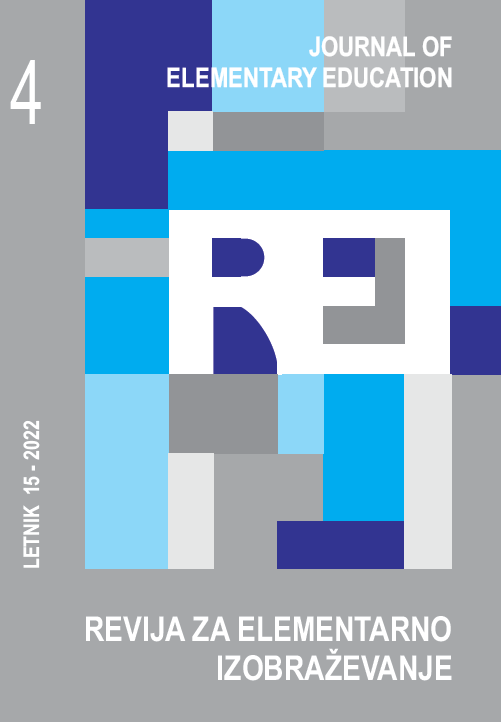The Role of Physical/Sporting Activities in Coping with Behaviour Problems among Primary School Students
DOI:
https://doi.org/10.18690/rei.15.4.409-425.2022Keywords:
primary school, discipline, hyperactivity, sport, healthy lifestyle.Abstract
Physical/sporting activities provide a child with opportunities to interact with others, validate and express him/herself, while also being critical factors in socialisation and the prevention of deviant behaviour. Therefore, in this study, we were interested in which physical/sporting activities are most strongly associated with the management of behaviour problems. Results from a representative sample of 1782 Slovenian primary school students show that a lack of physical/sporting activity is the strongest predictor of internalising behaviour problems. In this context, key roles are played by the frequency and intensity of activity, extracurricular sports activities, practising dance and limiting sedentary transportation to school.
Downloads
References
Blandford, S. (1998). Managing Discipline Schools. New York: Routledge. Pridobljeno s https://books.google.si/books?id=13oaXCiHbqAC&printsec=frontcover&hl=sl&source=gbs_ge_summary_r&cad=0#v=onepage&q&f=false (Dostopno 10. 10. 2017).
Colleen, C., Fedewa, A. L., in Ahn, S. (2017). The effect of physical activity on children with ADHD: A quantitative review of the literature. Journal of Applied School Psychology, 33(2), pp. 136–170.
Dolenc, P. (2010). Telesna samopodoba kot pomemben motivacijski dejavnik za gibalno/športno aktivnost otrok in mladostnikov. Revija za elementarno izobraževanje, 3(1), pp. 53–64.
Ekeland, E., Heian, F., Hagen, K. B., Abbott, J., in Nordheim, L. (2004). Exercise to Improve Self-Esteem in Children and Young People. The Cochrane Library, Chichester, UK: John Wiley & Sons.
EU Physical Activity Guidelines: Recommended Policy Actions in Support of Health-Enhancing Physical Activity. (2008). Bruselj, Belgija: Evropska komisija.
Gresham, F. M., in Elliott, S. N. (1990). Social Skills Rating System: Manual. ZDA, Minnessota: American Guidance Service.
Kamas, Z. A. K., Zubaidi, A. S. G. in Zaid, N. A. (2021). The role of play activities in reducing RMD in children of hyperactivity. PalArch’s Journal of Archaeology of Egypt / Egyptology, 18(4), pp. 1361–1385.
Kobolt, A. (2011). Razumevanje in odzivanje na čustvene in vedenjske težave. Socialna pedagogika, 15(2), pp. 153–173.
Kraljič, D. (2001). Mojster, kako si se tega naučil?: učenje zaznavanja skozi igro. Ljubljana: Zavod Republike Slovenije za šolstvo.
Krajnčan, M. (2007). Konceptualizacija preventivnih modelov v osnovni šoli. V T. Devjak (ur.), Pravila in vzgojno delovanje šole (pp. 119–141). Ljubljana: Pedagoška fakulteta, Univerza v Ljubljani.
Lee, Y., in Jeoung, B. (2016). The relationship between the behavior problems and motor skills of students with intellectual disability. Journal of Exercise Rehabilitation, 12(6), pp. 598–603.
Ng, Q. X., Ho, C. Y. X., Chan, H. W., Yong, B. Z. J., in Yeo, W. S. (2017). Managing childhood and adolescent attention-deficit/hyperactivity disorder (ADHD) with exercise: A systematic review. Complementary therapies in medicine 34, pp. 123–128.
Payne, K., J., in Ross, L. M. (2009). Simplicity Parenting, Using the Extraordinary Power of Less to Raise Calmer, Happier, and More Secure Kids. New York: Ballantine Books.
Pleško Zalar, T. (2018). Gibanje/šport in socialna pedagogika: tek kot metoda socialnopedagoškega dela. Socialna pedagogika, 22(1−2), pp. 51–74.
Schoeppe, S., Liersch, S., Röbl, M., Krauth, C., in Walter, U. (2016). Mothers and fathers both matter: the positive influence of parental physical activity modelling on children's leisure-time physical activity. Pediatric Exercise Science 28(3), pp. 466–472.
Smith, R. E., in Smoll, F. L. (1991). Behavioral research and intervention in youth sports. Behavior Therapy 22(3), pp. 329–344.
Šimunič, B., Pišot, R., in Planinšec, J. (2010). Uvodnik. V B. Šimunič, T. Volmut, in R. Pišot (ur.), Otroci potrebujemo gibanje: otrok med vplivi sodobnega življenjskega sloga: gibalne sposobnosti, telesne značilnosti in zdravstveni status slovenskih otrok (pp. 7–14). Koper: Univerza na Primorskem, Znanstveno-raziskovalno središče Koper, inštitut za kineziološke raziskave, Univerzitetna založba Annales.
Vahedi, S., Farrokhi, F., in Farajian, F. (2012). Social competence and behavior problems in preschool children. Iranian Journal of Psychiatry, 7(3), pp. 126–134.
Virag, Š., in Dolenc, P. (2016). Samopodoba in ukvarjanje s športom pri učencih šestega razreda osnovne šole. Revija za elementarno izobraževanje, 9(1−2), pp. 123–136.
World Health Organization (WHO). (2020). WHO Guidelines on Physical Activity and Sedentary Behaviour. Geneva: World Health Organization.
Zurc, J. (2012). Povezave med gibalno dejavnostjo in razvitostjo socialnih spretnosti pri otroku. Zdravniški vestnik, 81(12), pp. 847–860.
Zurc, J., in Jelovčan, G. (2017). Vloga športnih in gibalnih dejavnosti pri obravnavi vedenjskih težav mlajših šolarjev. V M. Kovač in M. Plavčak, Marjan (ur.), Zbornik 30. strokovnega in znanstvenega posveta športnih pedagogov Slovenije, 20.−21. oktober 2017, Debeli Rtič (pp. 216–227). Ljubljana: Zveza društev športnih pedagogov Slovenije
Downloads
Published
Issue
Section
License
Copyright (c) 2022 Joca Zurc, Giuliana Jelovčan, Vesna Štemberger

This work is licensed under a Creative Commons Attribution 4.0 International License.
